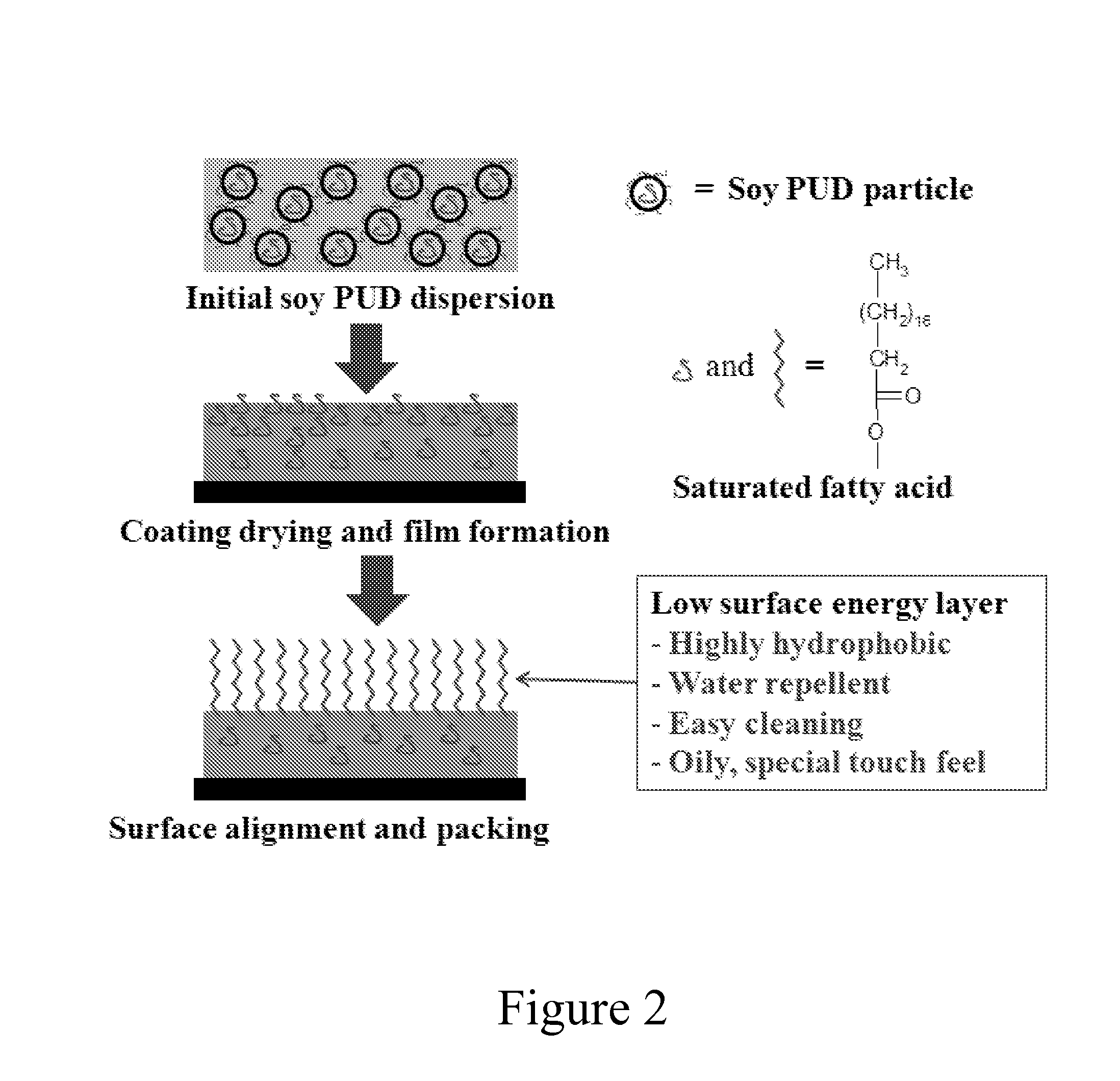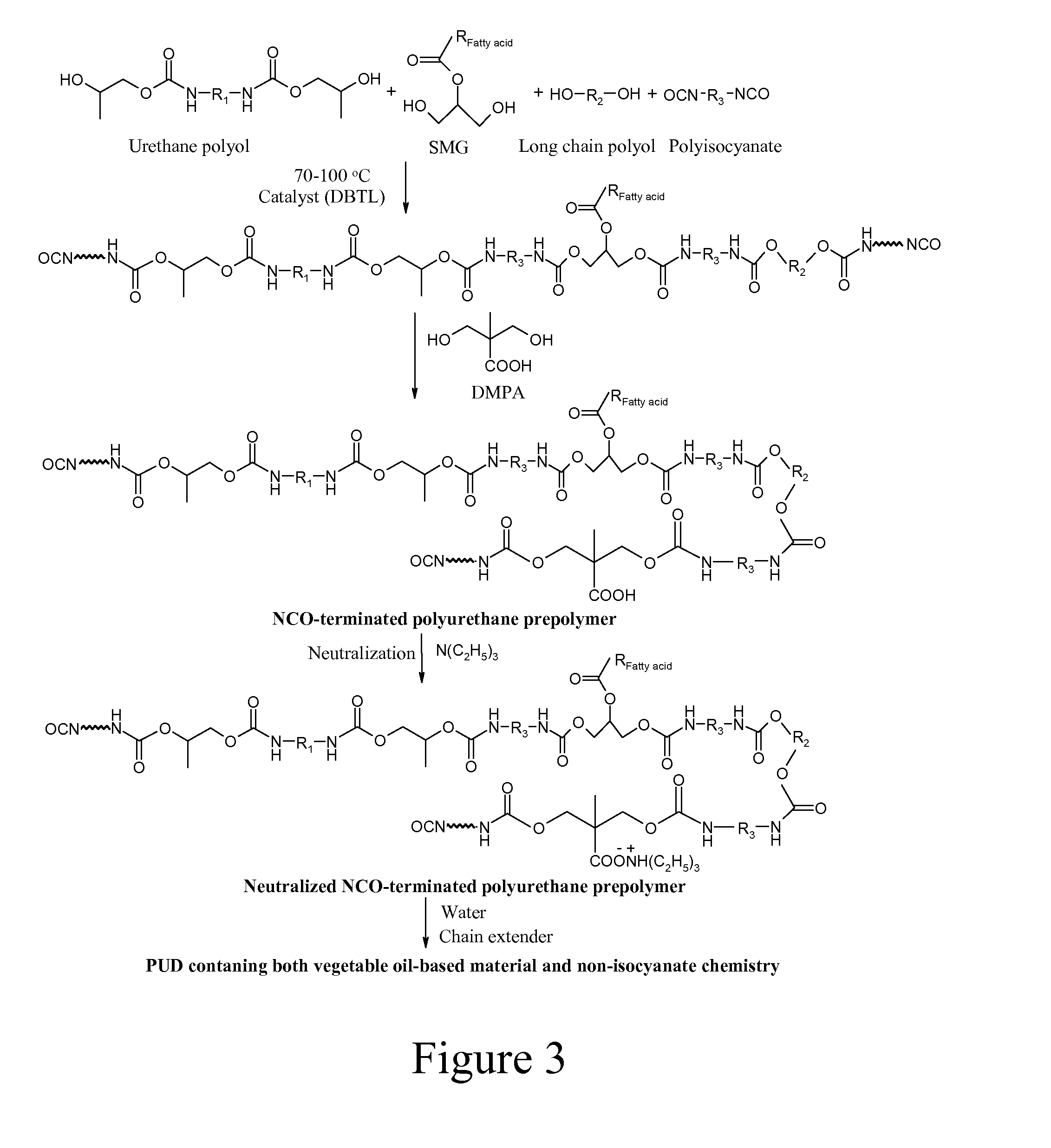Vegetable Oil-Modified, Hydrophobic Polyurethane Dispersions
a hydrophobic, vegetable oil technology, applied in the direction of polyurea/polyurethane coatings, coatings, etc., can solve the problems of increasing the high cost, and relatively high cost of vegetable oil, and achieve excellent surface properties and good mechanical properties
- Summary
- Abstract
- Description
- Claims
- Application Information
AI Technical Summary
Benefits of technology
Problems solved by technology
Method used
Image
Examples
example 1
Synthesis of Urethane Diol D230PC
[0052]Urethane diol D230PC was synthesized from propylene carbonate and JEFFAMINE D230 from Huntsman. 350 g (1.522 mol) of D230 and 310.8 g (3.044 mol) of propylene carbonate were added to a 1000 ml 3-neck round bottom flask equipped with a mechanical stirrer, a thermocouple and a nitrogen inlet. The mixture was heated to 120° C. and stirred under nitrogen protection. The conversion of cyclic carbonate groups to urethane groups was monitored using FTIR. The disappearance of the absorption peak at approximately 1800 cm−1 indicated the complete conversion of cyclic carbonate groups to urethane groups. The as-synthesized urethane polyols was dried under vacuum at 120° C. for 3 hours to remove any residual water.
example 2
Synthesis of Urethane Triol T403PC
[0053]Urethane triol T403PC was synthesized by the procedure described in Experiment 1. 440 g (1 mol) JEFFAMINE T403 from Huntsman and 306.3 g (3 mol) of propylene carbonate were used.
Synthesis of Vegetable Oil-Based PUDs
example 3-9
[0054]Calculated amount of SMG, D230PC, T403PC, MCR C61, MCR C62 and Terathane 2000 (based on Table 1) were placed in a jacketed glass reactor equipped with a mechanical stirrer, a thermocouple, a condenser and a nitrogen inlet. The reaction was carried out at 85° C. When a homogeneous mixture was reached under mechanical stirring in the reactor, IPDI was charged in the presence of one drop of dibutyltin dilaurate (DBTDL) catalyst. After one hour of reaction, DMPA and NMP mixture was added. The reaction temperature was kept at 85° C. and an appropriate amount of acetone was added to the reactor when necessary to lower the viscosity of the polyurethane prepolymers. When the desired free isocyanate content was reached (isocyanate content was tested according to ASTM D 2572-97), the reaction mixture was cooled down to 50° C. and a calculated amount of neutralization agent triethylamine was added. After 30 min of neutralization, the resulting prepolymers were dispersed in water under hi...
PUM
| Property | Measurement | Unit |
|---|---|---|
| number average molar mass | aaaaa | aaaaa |
| temperatures | aaaaa | aaaaa |
| number average molar mass | aaaaa | aaaaa |
Abstract
Description
Claims
Application Information
 Login to View More
Login to View More - R&D
- Intellectual Property
- Life Sciences
- Materials
- Tech Scout
- Unparalleled Data Quality
- Higher Quality Content
- 60% Fewer Hallucinations
Browse by: Latest US Patents, China's latest patents, Technical Efficacy Thesaurus, Application Domain, Technology Topic, Popular Technical Reports.
© 2025 PatSnap. All rights reserved.Legal|Privacy policy|Modern Slavery Act Transparency Statement|Sitemap|About US| Contact US: help@patsnap.com



